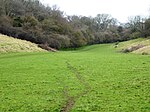Elham railway station

Elham railway station is a disused railway station on the Elham Valley Railway which served the village of Elham in Kent and the surrounding villages. Situated to the east of Elham the clapboard station was opened in 1887. In 1931 the line was singled and one platform was closed. Regular passenger services were withdrawn on 1 December 1940 when the line was taken over for military use. In 1946 the line was reopened for goods traffic but a year later this service ceased when the station was officially closed. After closure the station building was demolished but one platform still exists forming a retaining wall of a garden for a house now built on the station site.
Excerpt from the Wikipedia article Elham railway station (License: CC BY-SA 3.0, Authors, Images).Elham railway station
Duck Street, Folkestone and Hythe District
Geographical coordinates (GPS) Address Nearby Places Show on map
Geographical coordinates (GPS)
| Latitude | Longitude |
|---|---|
| N 51.151577 ° | E 1.115065 ° |
Address
Duck Street
Duck Street
CT4 6TW Folkestone and Hythe District
England, United Kingdom
Open on Google Maps








